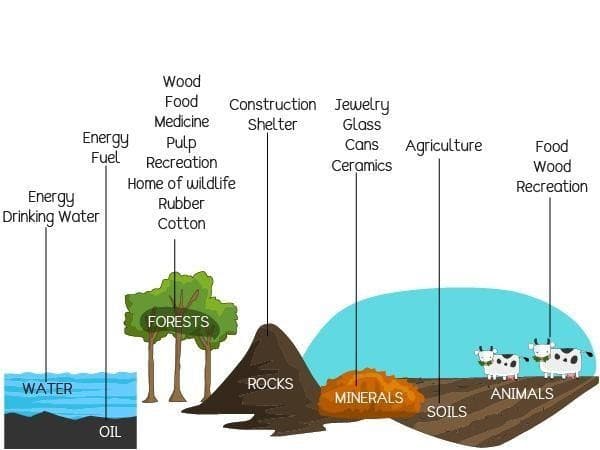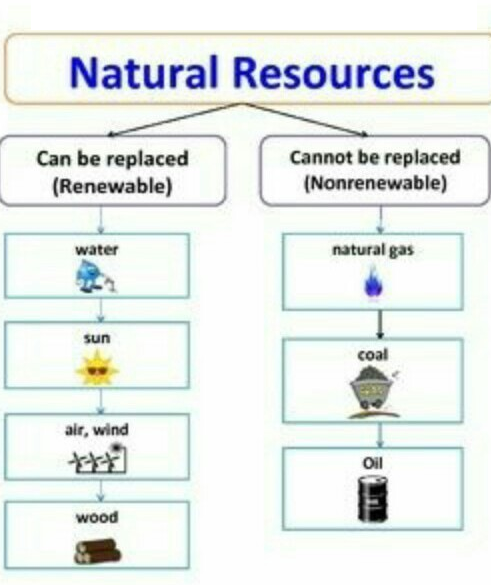Natural Resources - Types of Examples, Definition, FAQs
What are the Different types of Resources?
- Natural resources
- Man-made resources
Natural resources: Natural resources as the name suggests are those resources which are obtained from nature in natural ways i.e. human help is not needed for this purpose. Or We can also define natural resources as those resources which are found in the environment and further developed without any interaction of Humans. The Name of natural resources are Sunlight, air, water, soil, plants, animals and fossil fuels. Natural resources are those resources which occur naturally and these useful for living beings and by some modifications or purifications it can also be used for many other purposes like clothes, metals, fertilizers, fossil fuels etc.

Like in the picture we can define that water is used for drinking purposes and oil present underwater is the basic need of today i.e. used as a fuel. Forests have a number of uses, trees present in forests give us rubber, cotton, wood, food and many plants are used as a medicine. Forests are known as homes for wildlife animals. Rocks are necessary for construction and act as a shelter for many animals. Minerals are one of the most important natural resources as many used things like jewelry, ceramics, glass, iron, steel, etc are originated through minerals. Agriculture is said to be the lifeline for us as we produce food from this and agriculture is done due to the presence of soil. Animals are also said to be a natural resource as this provides us many useful items like wool, leather, silk, etc, and also provides us food.
Also read -
- NCERT Solutions for Class 11 Chemistry
- NCERT Solutions for Class 12 Chemistry
- NCERT Solutions for All Subjects
Types of Natural Resources:
On the basis of availability of resources these are categorized into two different categories known by the names:
1. Renewable Natural Resource: Renewable resources as the name suggested renewable i.e. can be used again and again. Those resources which are not going to be extinguished or we can say resources that are infinite in nature and can be used how many times we want are known as renewable natural resources. These resources are said to be sustainable in nature. These are useful for us due to their economically cheap price and eco-friendly nature. These refill quickly for example these will never run out from our system.
The main examples of Renewable Natural resources are wind, water, forest, etc.
2. Non-Renewable Natural Resource: Non-renewable i.e. those sources which cannot be renewed or those sources which are presently limited in nature that with the continuous use of these resources it can be exhausted from nature. Therefore these types of resources are known as exhaustible in nature. These are also costly and create pollution said to be less eco-friendly in nature. These can be refilled very slowly or after some time we will not be able to refill them as these are limited in nature.
Fossil fuels, minerals, etc are kept in the category of Non-renewable natural resources.
Hence these two types suggest that all natural resources are not renewable in nature.
Pictures of natural resources: Examples of resources are given below.

Important Types of Natural Resources:
There are a number of natural resources which may or may be renewable in nature. Out of all these resources, the main five natural resources are explained as follows:
1. Air: Air is one of the most important natural resources and is kept in the category of Renewable natural resources. As we know air is the gases present in our atmosphere or we can say that the atmosphere is because of gases or air present. Air is important for all living organisms to survive on this planet. The environment contains a number of gases in its air like Oxygen, nitrogen, carbon dioxide, carbon monoxide, etc. Life is not possible without good air so we have to take all strict actions to purify our air or for reducing air pollution.
2. Water: The second major natural resource is Water and it is kept in the category of Renewable natural resources. It is already known to us that 70% of our earth is covered with water. The major resources of water are rainfall, lakes, rivers, ponds, sea, etc. Out of these 70% water bodies, only 2% of water is pure in nature which we drink. We can’t imagine our life without the existence of water. Major uses of water are drinking, cooking, cleaning, etc. Hence we have to save water as much as we can and should not pollute the water by adding industrial or household waste into water bodies as it will be harmful to us and as well as for aquatic animals.
Also Read:
- NCERT Solutions for Class 11 Chemistry Chapter 14 Environmental Chemistry
- NCERT Exemplar Class 11 Chemistry Solutions Chapter 14 Environmental Chemistry
- NCERT notes Class 11 Chemistry Chapter 14 Environmental Chemistry
3. Soil: Soil is the most important resource for us and plants. Plants grow in soil and the crop we need to prepare food is also grown in the soil. Soil is also kept in the category of natural renewable resources as with the breakage of big mountains they get converted into soil. Soil consists of many organic minerals, air, water, etc. which are helpful for any plant or crop to grow. Soil is the basic source of nutrients for plants and animals and for many insects it is home i.e. soil provides shelter to them. Soil is used for agricultural purposes.
4. Iron: Iron is made up from silica and has so many uses like it is used in the construction of the building, other household things like almirah, table, chair, etc and also used in automobiles like cars, buses, etc. Iron is also used in making strong weapons. Iron is said to be non-renewable in nature; it cannot be renewed so we have to use this resource for our needs only.
5. Forests: Forest is said to be the most important natural resource which is useful for us as well as for animals. It provides shelter to animals and also provides food to them. Trees in forests also become the major resources of wood, paper, medicines, etc for us. But with the increasing population, the demand for construction increases which reduces the forest area and it will put an adverse effect on our environment as trees are the major sources which reduce the pollution.
This suggests that natural resources are very important for us so we have to follow some methods to conserve natural resources which can be discussed as follows:
- Don’t waste water.
- Save fuel by sharing the cabs, take public transport and for near distances use bicycles and walking. This will save the fuel as fuel is non-renewable in nature.
- Majorly use renewable energy resources rather than non-renewable one like using solar energy rather than consuming much light energy.
- Always remember the three R rules – Reuse, Reduce, Recycle.
- Always dig down the vegetable waste it helps in making compost which can be used further.
- Say no to those items which create pollution like plastic bags etc.
By understanding the concept of the use of natural resources we are able to save them.
Also check-
- NCERT Exemplar Class 11th Chemistry Solutions
- NCERT Exemplar Class 12th Chemistry Solutions
- NCERT Exemplar Solutions for All Subjects
NCERT Chemistry Notes: